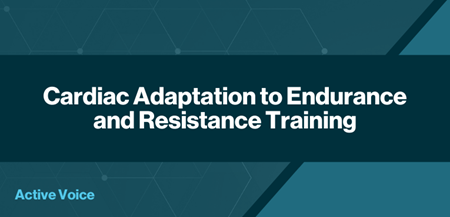by
Greg Margason
| Jul 18, 2022

In our Studies of Twin Responses to Understand Exercise THerapy (STRUETH) trial, we recruited monozygotic and dizygotic twin pairs and supervised them through three months of endurance training and three months of resistance exercise training. Each twin pair exercised together, at matched exercise prescriptions, and all subjects undertook both forms of exercise. We measured many outcomes, including body composition, fitness and strength, risk factors and vascular measures, but one of the most interesting outcomes involved cardiac magnetic resonance (CMR) assessments of heart chamber mass and volumes.
Not everyone responds to exercise in the same way, even when identical programs are administered. Thus, we were curious about the variability between individuals (and twin pairs) in heart muscle adaptation to training, and whether the modality of training affected this. An early study by Morganroth and colleagues in 1975 assessed different types of athletes, using the rudimentary echocardiography of that time, and reported distinct cardiac morphological findings between groups. From this grew the notion that endurance training induces eccentric hypertrophy (where ventricular volumes and mass increase), whereas resistance training leads to concentric hypertrophy (where mass and wall thicknesses increase, but volumes do not). But the original paper, and some that followed and supported the hypothesis, did not actually exercise-train the subjects. Rather, comparisons were cross-sectional and assumed that group differences were due to lifelong exercise exposure. However, athletes differ greatly in many ways, including body size and shape.
Our study, published in the July 2022 issue of Medicine & Science in Sports & Exercise®, provides further insight. Using CMR, we found evidence for increased left ventricular mass and volume in response to endurance training, supporting the idea of eccentric hypertrophy. Somewhat in contrast, resistance training in the same individuals did not modify left ventricular dimensions or mass. This brings into question the proposition that resistance training induces concentric hypertrophy. By looking at the individual responses, we were able to quantify the proportion of the sample with large, modest and nonresponse to each modality of training. These data showed that low responders to one mode of exercise were often high responders to the alternative!
The modes of exercise we used were very different, targeting cardiovascular function versus skeletal muscle hypertrophy. They might therefore be expected to induce changes in distinct gene subsets. Perhaps individuals are genetically predisposed to respond to one or other forms of training? However, our estimates based on actual changes induced by training indicated limited genetic impact on cardiac adaptation to either mode of training.
Like all studies, ours has some limitations. The training period was relatively short, different exercise interventions may induce other outcomes, and the subjects were young and healthy (though initially inactive). Our power for twin analysis was somewhat limited, especially in the dizygotic paired groups. Interestingly, 10 pairs of twins who were recruited to the dizygotic group based on their lifelong assumptions turned out to be monozygotic when we genotyped them. Few previous twin studies have genotyped their sample to verify zygosity — our data suggest that this is necessary in future.
Our findings provide further insight into the ongoing debate regarding the utility of searching for genetic determinants of trainability in humans. At the end of the day, most people respond to some form of exercise — the challenge for exercise physiologists remains to fit the best approach to each individual.

Daniel J. Green, Ph.D., is a cardiovascular physiologist who studies exercise, inactivity, and cardiovascular function and adaptation in humans. His research has encompassed the development of new imaging platforms to study the impact of lifestyle factors (particularly exercise) on human adaptation across the lifespan. Dr. Green is Winthrop Professor in Sport and Exercise Science at the University of Western Australia, and this work was completed during his tenure as a National Health and Medical Research Council of Australia (NHMRC) principal research fellow (APP1080914).

Louise Naylor, Ph.D., is an associate professor at the University of Western Australia and a senior accredited exercise physiologist who works in cardiac rehabilitation in the Cardiac Transplant Unit and Advanced Heart Failure Service at Fiona Stanley Hospital. As both a practitioner and researcher, Dr. Naylor aims to optimize the prescription of exercise for people both at risk of and with established cardiovascular diseases.
Viewpoints presented in SMB commentaries reflect opinions of the authors and do not necessarily represent ACSM positions or policies. Active Voice authors who have received financial or other considerations from a commercial entity associated with their topic must disclose such relationships at the time they accept an invitation to write for SMB.